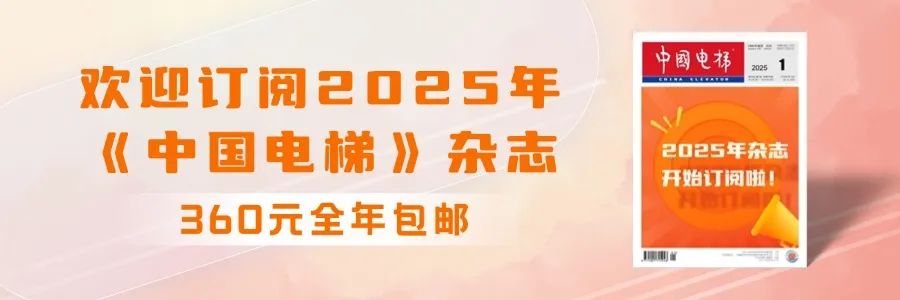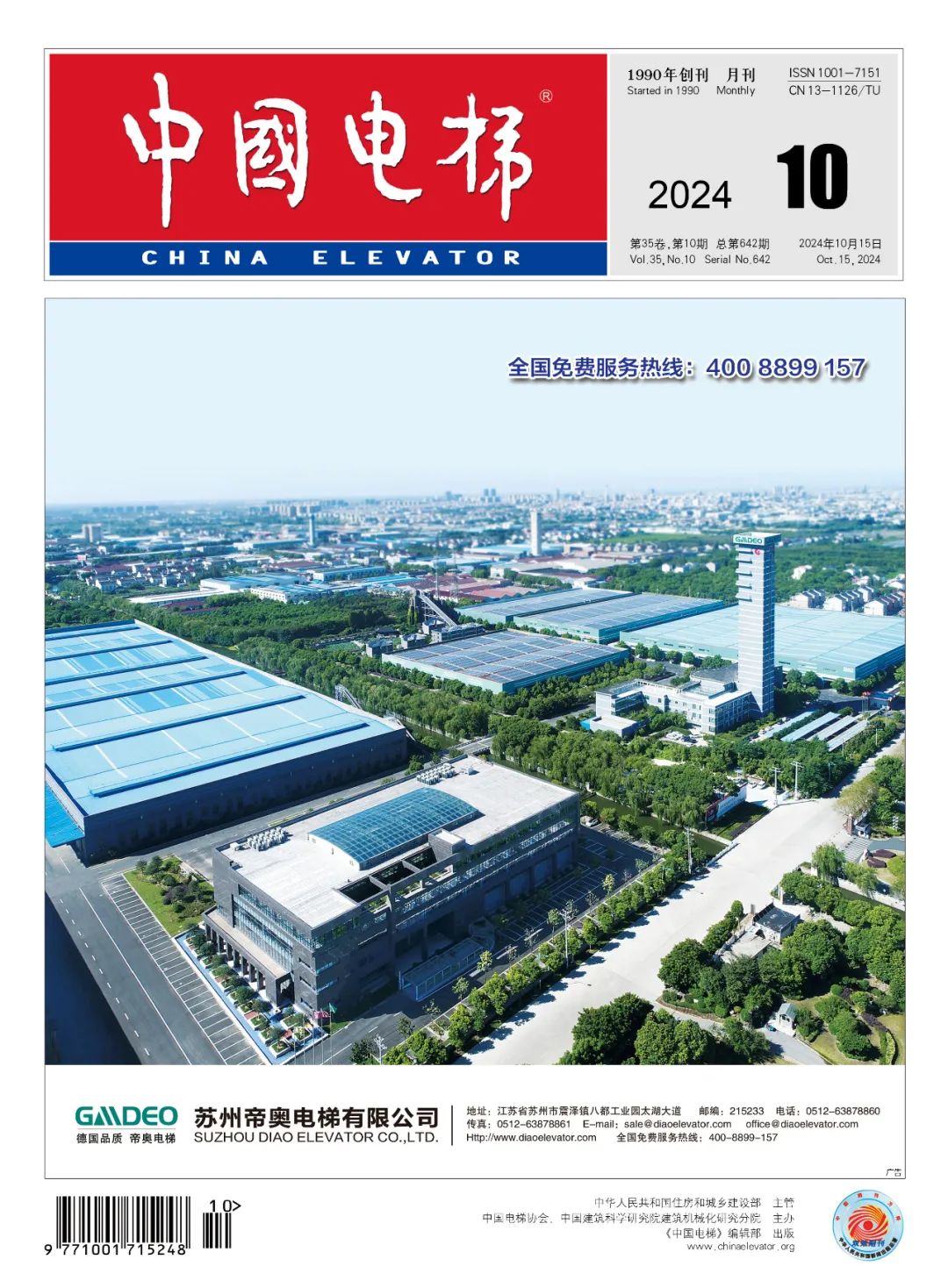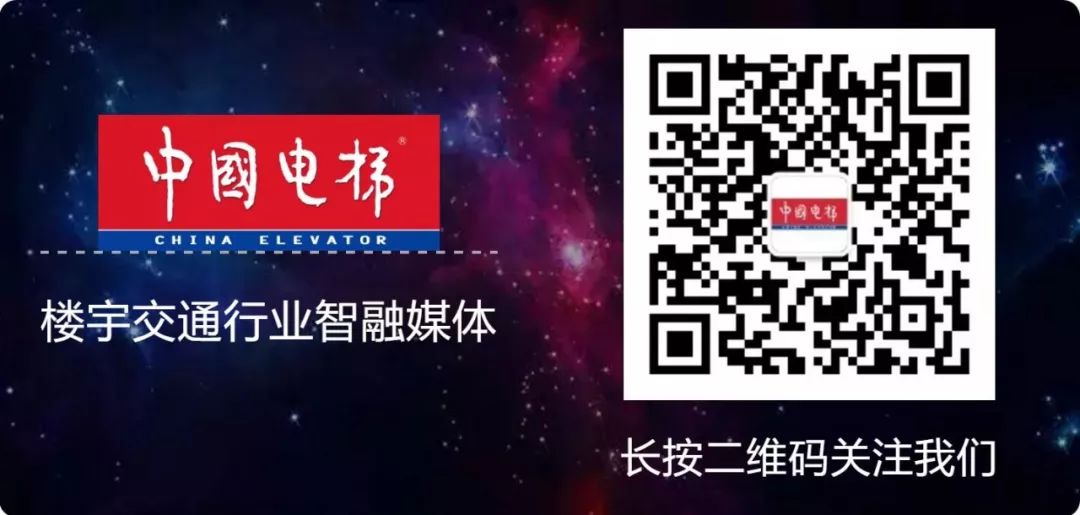
This article is published in the October 2024 issue of “China Elevator” magazine.
The Elevator Internet of Things is a system that uses Internet technology to connect elevators to Ethernet, allowing effective information and data exchange between elevator equipment, elevator companies, regulatory departments, maintenance companies, parts suppliers, property management companies, elevator passengers, industry associations, and real estate companies. This enables smart management of elevators and ensures their reliable operation. Therefore, the Elevator Internet of Things is an important means of building smart cities and an effective way to improve elevator service quality and safety levels.
The Elevator Internet of Things has a three-layer architecture: perception layer, network layer, and application layer. The perception layer is responsible for collecting audio, video, and operational data inside and outside the elevator, serving as the information source for the Elevator Internet of Things. The network layer provides multiple network transmission methods to achieve information intercommunication. The application layer is responsible for storing, analyzing, and processing the information transmitted from the perception layer, using technologies such as big data and artificial intelligence to provide intelligent decision support for elevator maintenance and property management.
Currently, the applications of the Elevator Internet of Things mainly include the following aspects.
1) By monitoring the elevator’s operating status in real-time, faults can be detected promptly, reducing the occurrence of accidents. Additionally, remote communication and video connections can be effectively utilized to communicate with individuals trapped in the cabin, shortening rescue times and ensuring passenger safety. Data analysis can also assess safety risks associated with elevators and provide a basis for safety supervision.
2) Utilizing remote debugging and fault elimination technology can reduce the on-site working time for maintenance personnel and improve maintenance efficiency. Data analysis can not only optimize the elevator’s operational performance and usage but also identify passenger usage demands and deficiencies in the elevator, providing references for product design and improvement.
3) Through data collection and sharing, comprehensive lifecycle management of elevators can be achieved (including manufacturing, installation, maintenance, inspection, and regulation), enhancing management transparency and traceability, and allowing for quality and service evaluation and supervision of elevators, thus improving management quality and standards.
China’s standard system related to the Elevator Internet of Things has gradually been established. Below, we will introduce it from three aspects: national standards, local standards, and group standards.
In 2017, the national standard GB/T 24476—2017 “Technical Specifications for the Elevator, Escalator, and Moving Walkway Internet of Things” was published. This standard first standardized the technical path and data standards of Elevator Internet of Things, including the network architecture of monitoring terminals, enterprise application platforms, and safety supervision platforms; it also standardized the elevator identification code, basic information, real-time operational status information, statistical information, as well as formats for fault, event, and alarm data.
In 2020, the national standard GB/T 38656—2020 “Technical Specifications for Data Exchange of Special Equipment Internet of Things Systems” was published. This standard stipulates the information requirements for data exchange between special equipment Internet of Things platforms.
Some provinces, cities, and autonomous regions in China have issued local standards regarding the Elevator Internet of Things based on their characteristics. For example, Jiangsu Province issued the DB32/T 2669—2014 “Technical Specifications for Public Safety Monitoring Networks for Elevators” series of standards, DB32/T 3678—2019 “Unified Emergency Rescue Identification for Elevators”, DB32/T 4131—2021 “Data Collection Specifications for Elevator Emergency Response Services”; Beijing issued the DB11/T 948—2013 “Technical Specifications for Elevator Operation Safety Monitoring Information Management Systems” series of standards; Henan Province issued the DB41/T 1643—2018 “Technical Specifications for Elevator Operation Monitoring Systems” series of standards, DB41/T 1722—2018 “Data Specifications for Elevator Emergency Response Platforms”; Chongqing issued the DB50/T 568—2014 “Technical Requirements and Testing Specifications for Elevator Operation Monitoring Systems”; Sichuan Province issued the DB51/T 1573—2013 “General Technical Requirements for Elevator Operation Safety Monitoring Systems”, etc.
These local standards mainly regulate aspects such as data formats, technical requirements, testing methods, and emergency response for elevator operation monitoring systems, providing specific guidance and references for the application of the Elevator Internet of Things. These standards also reflect the emphasis and support from various regions for the Elevator Internet of Things, creating favorable conditions for its promotion and application.
In June 2019, the China Special Equipment Safety and Energy Conservation Promotion Association issued the group standard T/CPASE MG 007—2019 “Information Coding and Data Format for Elevator Internet of Things Collection”. This standard expanded elevator fault information, real-time operational status information, and specified information coding, data frames, and data transmission formats. In November of the same year, the T/CPASE M 001—2019 “Technical Specifications for Elevator Emergency Response Platforms” was also issued. This standard stipulates the requirements for the construction, operation services, and data collection of elevator emergency response platforms.
In December 2021, the China Special Equipment Safety and Energy Conservation Promotion Association issued a series of group standards T/CPASE M 014.1—2021 “Elevator Product Traceability Part 1: Coding and Identification Rules”, T/CPASE M 014.2—2021 “Elevator Product Traceability Part 2: Information and Data Format”, and T/CPASE M 014.3—2021 “Elevator Product Traceability Part 3: Technical Requirements for Data Exchange and Transmission Interfaces”. This series of standards stipulates the technical requirements for quality and safety information traceability coding, traceability information, and traceability platforms throughout the entire lifecycle of elevator complete machines and components (manufacturing, installation, modification, repair), operation, inspection, testing, and supervision management.
In August 2022, the China Elevator Association issued the group standard T/CEA 7000—2022 “Guidelines for the Construction of Elevator Internet of Things Standard System”. This standard systematically plans and constructs the standard system related to the Elevator Internet of Things based on its development needs and goals, aiming to achieve intelligent management and supervision of elevators. In May 2023, the national standards GB/T 24476—2023 “Basic Requirements for Elevator Internet of Things Enterprise Application Platforms” and GB/T 42616—2023 “Technical Specifications for Elevator Internet of Things Monitoring Terminals” were published, replacing GB/T 24476—2017.
The application of the Elevator Internet of Things needs to consider both the general IoT standards and the particularity of elevators as special equipment, while the current coordination and cooperation among national standards, industry standards, and local standards are insufficient, leading to a lack of uniformity in the application of the Elevator Internet of Things. Although various regions have introduced standards for elevator operation monitoring systems, the lack of uniformity makes data standardization quite difficult. At the same time, due to the varying levels of construction of the Elevator Internet of Things, there are significant differences in data collection methods and formats between different platforms, making effective data integration and sharing challenging. Furthermore, the response speed between departments is slow, making it difficult to share relevant information between departments, and hindering the implementation of pre-risk warnings, inter-rescue coordination, and post-risk management. Information security risks are also a significant issue, as various platforms do not pay enough attention to data security, exposing them to risks of information leakage and lack of disaster recovery capabilities. Specifically, these problems can be categorized into the following aspects.
1) The standards for the Elevator Internet of Things have not yet formed a complete system, with various standards at different levels being redundant, conflicting, or missing. Differences in data formats, coding methods, and transmission protocols between national and local standards hinder data intercommunication and sharing. Additionally, relevant standards do not comprehensively cover all application scenarios and fields, such as standards for elevator energy conservation, fault diagnosis, and product improvement are still relatively lacking, limiting the application range and effectiveness of the Elevator Internet of Things.
2) Elevator Internet of Things data has not yet achieved effective integration and sharing. There is a phenomenon of “data islands” between various platforms, reducing data utilization and value. The inconsistency in data collection methods and formats across different links leads to difficulties in data exchange and transmission, and the interconnection of Elevator Internet of Things data with other intelligent systems and urban infrastructure systems has not yet been realized, limiting the application range and effectiveness of the data.
3) There is weak collaboration and slow coordination between units and departments. Currently, information communication and feedback between departments lag, especially when elevators malfunction or accidents occur, data sharing and coordination among maintenance companies, regulatory departments, property companies, and rescue departments are delayed, leading to reduced rescue efficiency and quality. Furthermore, a lack of an effective supervision and evaluation mechanism makes it difficult to enhance the quality and standards of the Elevator Internet of Things.
4) Information security issues are prominent. Various platforms do not attach enough importance to data protection and backup, posing potential risks of data leakage and loss. During data transmission and storage, there may be attacks or destruction from hackers, leading to data tampering or deletion. At the same time, the data transmission of the Elevator Internet of Things lacks effective encryption and authentication measures, threatening data privacy and security.
The development needs for standardization of the Elevator Internet of Things mainly include top-level design standards, data standards, safety standards, and application standards.
1) Top-level design standards are considered the foundation and guidance for the standardization construction of the Elevator Internet of Things. A complete and systematic framework of standards for the Elevator Internet of Things should be established, clarifying the overall architecture, technical route, functional requirements, and safety requirements to ensure system integrity and continuity.
2) Data standards are the core and key of the standardization construction of the Elevator Internet of Things. Data collection, transmission, exchange, storage, analysis, and other aspects should be standardized to ensure data consistency, interoperability, and security, promoting data sharing and application. Data standards involve elevator identification codes, basic information, real-time operational status, as well as various data types such as faults, events, alarms, and statistics, and should standardize formats, coding, protocols, interfaces, and other elements to provide unified standards and specifications for data processing and application of the Elevator Internet of Things.
3) Safety standards are the guarantee and prerequisite for the standardization construction of the Elevator Internet of Things. Risk assessment, safety protection, monitoring mechanisms, emergency response, and other aspects should be standardized to ensure high safety and reliability, safeguarding operational and information security. Safety standards involve multiple levels such as physical security, network security, and data security, and should standardize technical measures, management measures, response measures, and other elements to provide unified standards and specifications for the safe operation and management of the Elevator Internet of Things.
4) Application standards are the purpose and result of the standardization construction of the Elevator Internet of Things. Comprehensive standards should be developed for different application scenarios and fields, including maintenance management, fault warning, emergency response, product improvement, and other methods, processes, and specifications to improve elevator service quality and efficiency. Innovative application models and solutions should be developed based on data analysis and intelligent technologies to provide unified standards and specifications for the application of the Elevator Internet of Things.
5. Standardization System Roadmap for Elevator Internet of Things
To promote the promotion and application of the Elevator Internet of Things, it is necessary to develop a related standardization system roadmap and establish a complete and systematic system to support the development and innovation of the Elevator Internet of Things.
The standardization system roadmap for the Elevator Internet of Things includes: researching the current status and needs of the Elevator Internet of Things, developing top-level design standards, data standards, safety standards, application standards, organizing standard promotion and training, and conducting standard supervision and updates. First, it is necessary to comprehensively understand the current status and development needs of the Elevator Internet of Things, analyze its technical characteristics, standard status, market demands, and safety risks, and determine the goals and direction for standardization construction of the Elevator Internet of Things. Secondly, develop top-level design standards, data standards, safety standards, and application standards according to the development needs of the Elevator Internet of Things standardization. Then, after the standards are completed, actively promote their dissemination and popularization, and organize standard training, seminars, and promotional activities to enhance practitioners’ awareness and application of the standards. Finally, an essential supervision mechanism is crucial for the effective implementation and feedback of the standards, facilitating timely revisions and updates of the standards by the standard-setting departments to adapt to changes in technology and market.
6. Conclusion
To achieve effective application of the Elevator Internet of Things, standardization construction is crucial. By developing top-level design standards, data standards, safety standards, and application standards, the development of the Elevator Internet of Things can be standardized, ensuring its safe, reliable, and efficient operation. At the same time, it is necessary to establish a complete standard promotion and supervision mechanism to ensure the effective implementation and continuous updating of the standards to meet the development needs of the industry. In the future, with the continuous development of IoT technology, the Elevator Internet of Things can also interconnect with other intelligent systems and urban infrastructure, achieving a higher level of smart city construction. As the standardization construction progresses, the Elevator Internet of Things will bring more convenience and safety to people’s lives and contribute to sustainable urban development.

 Are you “watching” me?
Are you “watching” me?